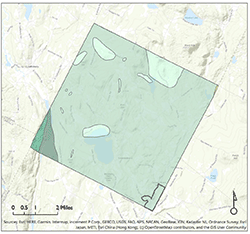Greensboro Bend
Bedrock Geology
Rocks are ubiquitous and mysterious. They form the foundation of societies, crunch beneath our feet, hold valued places in our collections, and provide clues to the story of Earth’s history.

Map of Greensboro BedrockThe Waits River Formation is the primary type of bedrock found in Greensboro. The formation runs the entirety of Vermont, from Canada in the north to Massachusetts in the south. The bedrock is mainly comprised of a metamorphosed (heat and pressure) sedimentary rock. Before being metamorphosed, this rock consisted of “calcite-rich sandstone” interlayered with shale (mud). When the rock was metamorphosed, the calcite in the sandstone recrystallized, forming a “dirty” marble, whereas the clay minerals in the shale transformed into mica. Brown weathering of the rock is likely a result of the exposure of iron and/or pyrite to the air. Below is a tour of the geologic history of this region.
1.3 - 1 billion years ago | Precambrian
Orogenies, or mountain-building events, formed historic and present-day mountain ranges. The first mountain-building event whose remnants are preserved in some of Vermont’s bedrock was the Grenville Orogeny. During the assembly of Rodinia, the second most recent supercontinent on Earth, the eastern margin of what is now North America converged with other fragments from the breakup of a previous supercontinent. It created mountains as high as the modern-day Himalayan range, which reach nearly 30,000 feet, about seven times the height of Mt. Mansfield. The Grenville Mountains spanned from Canada to Mexico, inland of the modern-day Appalachians.
Life at the time: photosynthesis and multicellular life have evolved—blue-green algae, bacteria, and slime molds.
600 million years ago | Precambrian
Rodinia began to break apart, forming rift valleys. During this process, sand, mud, and gravel accumulated in the opening rift valleys. The Grenville Mountains continued to slowly erode. Streams carried sediments to these valleys, where they were deposited as lake sediments and alluvial fans—fan-shaped deposits of sediment built by streams.
Life at the time: green algae, fungi, and the first of the animals—segmented worms
550-540 million years ago | Cambrian
An ancient waterbody, the Iapetus Ocean, formed where the old continent, Rodinia, rifted apart. Shell-building marine animals living in this ocean combined calcium and carbonate from the surrounding ocean water to create the mineral calcium carbonate, the building block of their shells. Calcite, a form of calcium carbonate, is a major component of the bedrock and the overlying till and soils in Greensboro. Calcite is a rock type found in the Waits River Formation, the primary type of bedrock found in Greensboro.
Life at the time: the “Cambrian explosion,” the rapid diversification of marine life, begins—corals, jellyfish, clams, snails, trilobites, and the first vertebrates.
500-480 million years ago | Cambrian & Ordovician
The continents on either side of the Iapetus Ocean began to converge. A plate boundary developed within the Iapetus Ocean, where rocks beneath the ocean on one side of that boundary began to subduct beneath rocks on the other side of that boundary. As a result, a volcanic island arc formed between the continents, nearly parallel to the east coast of North America.
Life at the time: evolution of marine invertebrates—horseshoe crabs, sea stars, squid, and octopuses
480-450 million years ago | Ordovician
The volcanic island arc collided with eastern North America, resulting in the Taconic Orogeny. The Taconic and Green Mountains formed.Life at the time: jawless fish and sea urchins
370-345 million years ago | Devonian & Carboniferous
Avalonia, a microcontinent, collided with North America, resulting in the Acadian Orogeny. Plumes of magma beneath the earth’s surface, known as plutons, intruded during this process. The magma slowly cooled, forming granite. These granites exist on the north shore of Caspian Lake, on the northwest shore of Long Pond, and in several other locations throughout north-northwest Greensboro.Life at the time: club mosses, mosses, horsetails, ferns, mayflies, dragonflies, sharks, and bony fish
300-280 million years ago | Carboniferous & Permian
Vermont’s geology was not directly impacted during this time. The Iapetus Ocean closed during this period and Africa joined North America, forming the supercontinent Pangea.
Life at the time: the first land invertebrates (amphibians and reptiles); beetles; gymnosperms (non-flowering plants: conifers, gingko, cycads); and angiosperms (flowering plants) diversify.
200-105 million years ago | Jurassic & Cretaceous
Due to the stretching of the continental crust, the Connecticut River Valley and Champlain Valley became rift basins and received sediment inputs from surrounding mountains.
Life at the time: coevolution of flowering plants and insects; birds, large marine reptiles, and dinosaurs
20 million years ago | Miocene
Little geologic history is preserved between 105 million years ago and the most recent glaciation.
Life at the time: flowering plants; dinosaurs are extinct, except for birds; mammals, including the earliest apes